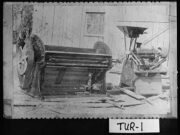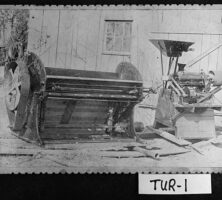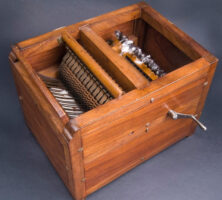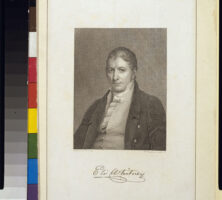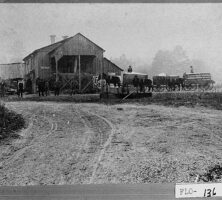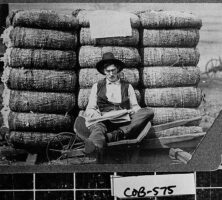The modern cotton gin, first patented by Massachusetts native Eli Whitney while in Georgia in 1793, is a simple machine that separates cotton fibers from the seeds. The gin (short for engine) consists of wire teeth mounted on a boxed rotating cylinder that, when cranked, pulls cotton fiber through small grates to separate the seeds, while a rotating brush removes lint from the spikes to avoid jams. Its invention quickly transformed the course of agriculture in the Deep South, and in so doing deepened the reliance of southern society on slavery and the plantation system.
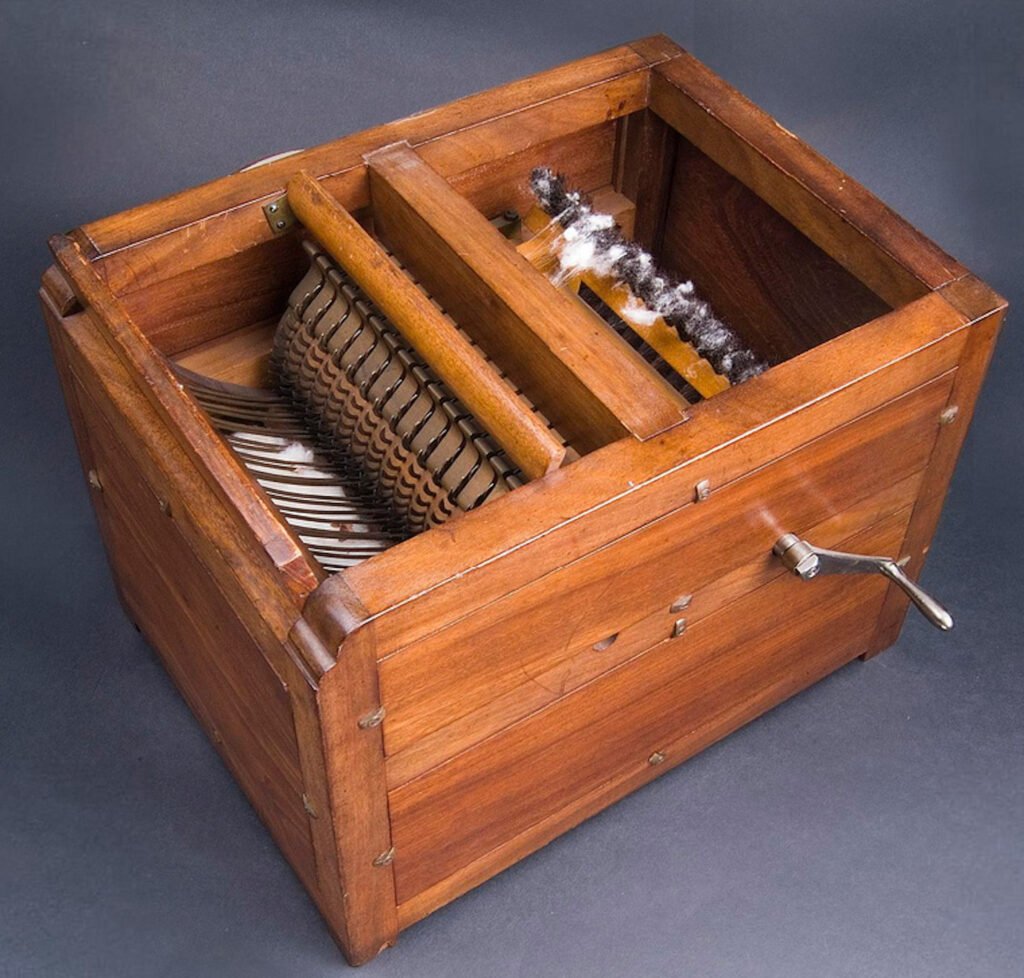
Image from National Museum of American History, Smithsonian Institution
Whitney’s Invention
When Whitney first moved to Georgia in 1793, short-staple cotton had only recently been introduced to Georgia as a major market crop. Small crops of long-staple, or Sea Island, cotton had been successfully cultivated along the coast since the close of the American Revolution (1775-83) but could not be grown upland. Only short-staple cotton could be grown upland, but early efforts by planters to profit from this variety were thwarted by the time-consuming task of removing the sticky green seeds from the cotton fibers, which were short in length and covered the entire seed surface. The seeds could only be removed by hand, which proved slow and inefficient; Whitney once remarked to a friend that he had never met anyone able to clean more than one pound a day. With Georgia’s tobacco industry in steady decline due to soil exhaustion and oversupply, planters desperately needed a way to make the cultivation of short-staple cotton profitable.
The state of Georgia appointed a commission to solve the problem, and efforts were made to create a device that could efficiently clean short-staple cotton. Long-staple cotton gins had existed long before Whitney’s invention of the short-staple cotton gin; the churka (or charkha), for instance, had been used in India for centuries to clean long-staple cotton, and was introduced to the South in the mid-eighteenth century.
The churka was a small, hand-operated machine that used two hardwood pinch-rollers to grip the cotton fiber and pull it away from the seed, but the device was useless on the short-staple variety of upland Georgia. Successful modifications of the churka soon followed its introduction. In 1772 Mr. Krebs of Pascaguola, in present-day Mississippi, created a gin similar to the churka that was introduced six years later in Georgia, and in 1788, Joseph Eve of Augusta patented an improved version that used a method that came to be known as “roller” ginning. Despite the success of these machines in cleaning the long-staple cotton of Georgia’s coastal areas, nothing existed to quickly and easily clean short-staple cotton prior to Whitney’s invention.
In 1793, with the success of Georgia’s cotton industry at stake, Whitney set to work in a workshop provided by Catharine Greene (the widow of Nathanael Greene, by whom Whitney was employed as a tutor on the Greene plantation, Mulberry Grove). Within months Whitney had used his familiarity with New England textile machinery to produce a working cotton gin that could produce up to fifty pounds of cotton daily. A small version of his design could be operated by hand, while larger versions could be powered by horses or water.
The Key to the Cotton Kingdom
The economic impact of Whitney’s gin was vast; after its invention, the yield of raw cotton nearly doubled each decade after 1800. The gin, whose invention coincided with much of the Deep South’s opening to white settlement, helped to facilitate westward expansion into these potential cotton-producing areas. By the mid-nineteenth century America was supplying three-quarters of the world’s cotton.
Although Whitney’s gin made cotton production profitable for Georgia and the rest of the Southeast, there were many problems with the machine’s design from the outset. While the gin increased considerably the amount of cotton that could be produced, the relatively low quality of the short-staple cotton fibers, combined with damage caused by Whitney’s gin, resulted in the cotton of upland Georgia selling for half the price of long-staple cotton. Upland farmers, however, had little choice, and their widespread use of Whitney’s design greatly expanded southern cotton production.
A direct result of this growth was an expansion of slavery. While the cotton gin reduced the amount of labor required to remove the seeds from the plant, it did not reduce the number of enslaved laborers needed to grow and pick the cotton. The demand for Georgia’s cotton grew as new inventions such as spinning jennies and steamboats were able to weave and transport more of the crop. Although the percentage of enslaved population to total population remained virtually unchanged from 1790 until 1860, the number of enslaved African Americans in the South increased dramatically. By the end of the antebellum era Georgia had more enslaved people and slaveholders than any state in the Lower South.
Patent Problems
The cotton gin’s invention served as the first test of the newly created U.S. patent system. The technical problems of Whitney’s design led to almost immediate modifications that were put into place by other farmers and inventors. The wire teeth on the revolving cylinder, for example, were quickly replaced by a series of circular saws. The origins of the modification are foggy, but as more gins with these saws were distributed, Whitney claimed that their design was an obvious variation of his own, and thus covered under his patent. Though the courts ruled in Whitney’s favor, countless legal battles ensued due to the shaky nature of Whitney’s patent.
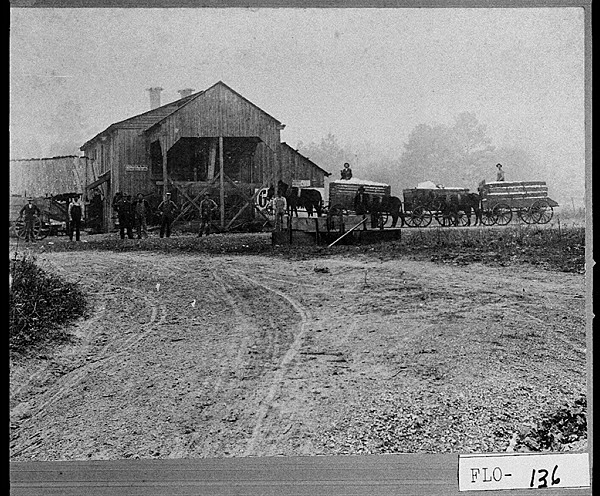
Courtesy of Georgia Archives.
Whitney and Phineas Miller, his business partner, had originally decided to produce a large number of gins, install them throughout Georgia and the South, and charge farmers a fee for using the gins. Farmers throughout Georgia resented having to pay what they felt was an exorbitant tax, and opted instead to make their own variations of Whitney’s design. Miller brought lawsuits against the makers of these lifted versions, but because of a loophole in the wording of the 1793 patent act, he and Whitney were unable to win any suits until 1802. In a desperate effort to make a profit, Whitney and Miller began selling licenses to manufacture the gin, but they failed to make a large return by the time Whitney’s patent expired in 1807. Whitney’s troubles were the first test of whether the nation’s new patent system could interpret what a patent could and could not protect, and it helped to shape the laws by which the system now operates.
Though most evidence indicates that Whitney was the sole inventor of the cotton gin, many historians believe that he was either aided or preceded by another in the design and invention of the machine. The most widely circulated claim to the invention of the cotton gin has been argued on behalf of Catharine Greene, Whitney’s hostess. Greene was deeply interested in the solution to the mechanical problems presented by the processing of short-staple cotton, and many have contended that she aided Whitney in the gin’s creation but avoided the connection of her name to the invention. Other historians have credited Hogden Holmes, a Scottish immigrant; Robert Watkins, an Augusta businessman and attorney; and William Longstreet, inventor of the precursor to the sewing machine, with the saws that made the gin a profitable success; all three of these men were issued patents for improvements to the cotton gin by 1796. Most evidence indicates, however, that Whitney did invent the saw gin.
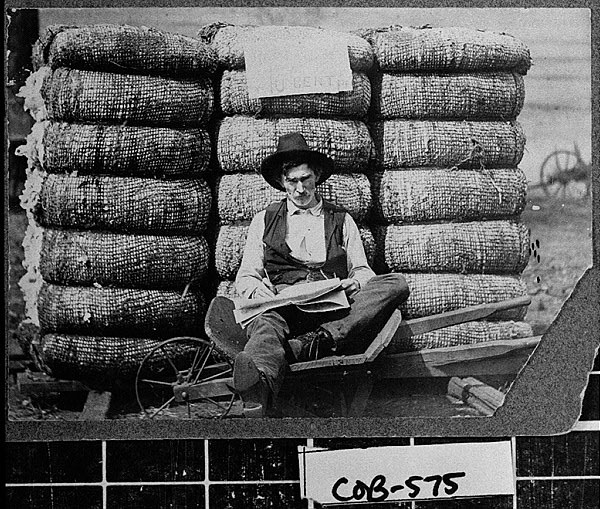
Courtesy of Georgia Archives.
Later Developments
During the 1820s the first successful cotton gin factories appeared. Before the Civil War (1861-65) the cotton gins they produced were sold primarily to farmers, who would install them on their property and use them to gin their own cotton. After the Civil War, however, farmers were more likely to take their seeded cotton to a ginner, who would remove the seeds for a fee in a method called “custom ginning.” The factory setting of custom ginning demanded efficiency during the whole ginning process, rather than just of the gin itself, and innovations in ginning began to focus more on the quantity and speed with which these factories could process cotton.
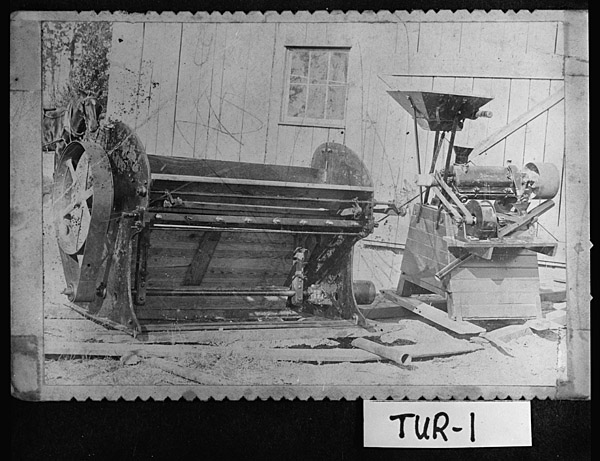
Courtesy of Georgia Archives.
In the mid-1880s Robert Munger of Texas developed “system ginning,” a process by which seeded cotton was fed continuously into multiple gins stands, from which the fiber was immediately pressed and baled. Munger’s system effectively ended the era of plantation gins and small cotton-gin makers and merchants.
The modern cotton ginning process has continued in Georgia and the Southeast and can also be found in the major cotton producing areas of the southwestern United States and overseas. Cottonseed oil, one of the by-products of cotton production, is commonly used in potato chips and other processed foods. Some consumers are wary of cottonseed oil in foods, as it contains highly toxic gossypol, and is taken from one of the most chemically intensive crops grown in the United States.
Today, only a few technologically sophisticated firms produce cotton gins based on the designs of specialized engineers. The largest of those companies, the Lummus Corporation, located in Savannah, has brought short-staple cotton production back to its roots at Mulberry Grove.


